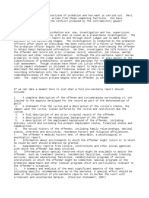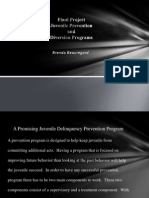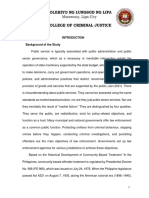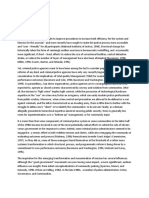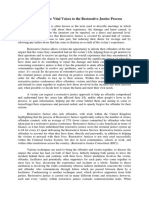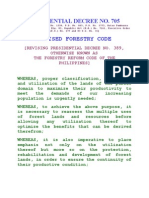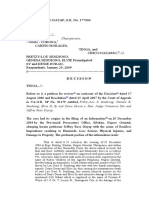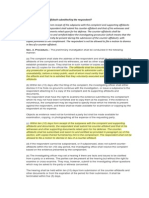0 ratings0% found this document useful (0 votes)
51 viewsIntr Intr Intr Intr Oduction Oduction Oduction Oduction: by Tracy M. Godwin
Intr Intr Intr Intr Oduction Oduction Oduction Oduction: by Tracy M. Godwin
Uploaded by
clandestine2684Restorative justice focuses on repairing harm and rebuilding relation-ships. Appa convened a focusgroup in March 2000 to examine the role ofrestorative justice in teen courts. The focusgroup generated a dynamic discussion of issuesbased on guiding questions. This paper will address the key issues that serve as a promising foundation.
Copyright:
© All Rights Reserved
Available Formats
Download as PDF, TXT or read online from Scribd
Intr Intr Intr Intr Oduction Oduction Oduction Oduction: by Tracy M. Godwin
Intr Intr Intr Intr Oduction Oduction Oduction Oduction: by Tracy M. Godwin
Uploaded by
clandestine26840 ratings0% found this document useful (0 votes)
51 views8 pagesRestorative justice focuses on repairing harm and rebuilding relation-ships. Appa convened a focusgroup in March 2000 to examine the role ofrestorative justice in teen courts. The focusgroup generated a dynamic discussion of issuesbased on guiding questions. This paper will address the key issues that serve as a promising foundation.
Original Title
role-of-rj
Copyright
© © All Rights Reserved
Available Formats
PDF, TXT or read online from Scribd
Share this document
Did you find this document useful?
Is this content inappropriate?
Restorative justice focuses on repairing harm and rebuilding relation-ships. Appa convened a focusgroup in March 2000 to examine the role ofrestorative justice in teen courts. The focusgroup generated a dynamic discussion of issuesbased on guiding questions. This paper will address the key issues that serve as a promising foundation.
Copyright:
© All Rights Reserved
Available Formats
Download as PDF, TXT or read online from Scribd
Download as pdf or txt
0 ratings0% found this document useful (0 votes)
51 views8 pagesIntr Intr Intr Intr Oduction Oduction Oduction Oduction: by Tracy M. Godwin
Intr Intr Intr Intr Oduction Oduction Oduction Oduction: by Tracy M. Godwin
Uploaded by
clandestine2684Restorative justice focuses on repairing harm and rebuilding relation-ships. Appa convened a focusgroup in March 2000 to examine the role ofrestorative justice in teen courts. The focusgroup generated a dynamic discussion of issuesbased on guiding questions. This paper will address the key issues that serve as a promising foundation.
Copyright:
© All Rights Reserved
Available Formats
Download as PDF, TXT or read online from Scribd
Download as pdf or txt
You are on page 1of 8
I nt r I nt r I nt r I nt r I nt roduct i on oduct i on oduct i on oduct i on oduct i on
The American Probation and Parole Association convened a
focusgroup in March 2000 to examine and discussthe role of
restorative justice in teen court programs, also commonly called youth
courtsand peer courts. There hasbeen considerable debate and
discussion over the past several yearsasto whether and how teen
courtscan incorporate restorative justice principlesinto their practices.
However, the meeting in March represented the first discussion
focused exclusively on the subject.
A panel consisting of personsworking actively in teen court
programsand personsworking actively in more traditional restorative
justice-based programswasbrought together for the two-day meeting.
The focusgroup generated a dynamic discussion of issuesbased on
guiding questionsidentified in the Guidefor Implementingthe
Balanced and RestorativeJusticeModel (Pranis, 1998). It isimpossible
to describe the magnitude of information that wasgenerated by the
processwithin the constraintsof thispaper. However, thispaper will
addressthe key issuesthat serve asa promising foundation from which
teen courtscan begin to movetoward integrating morerestorative
justice-based practiceswithin their programs.
Overview of Rest orat ive
Just ice Principles
Before discussing how teen courtscan become more restorative in
nature, it isimportant to understand some of the overall principles
and goalsof restorative justice. There are numerousarticlesand books
devoted to describing the restorative justice model. Therefore, this
paper will provide a brief synopsisof the concept asopposed to an
exhaustive description. A brief list of suggested supplemental
resourceson restorative justice may be found at the conclusion of this
paper.
Background
Restorative justice outlinesan alternative philosophy for address-
ing crime. When viewed from a restorative lens, crime isa violation
of people and relationships the relationshipsbetween the offender
and hisor her family, friends, victims, and the community as
opposed to merely an act against the state (Zehr, 1990). In essence,
restorative justice focuseson repairing harm and rebuilding relation-
shipsthrough a processthat involvesstakeholdersin an active and
respectful way, while emphasizing the communitysrole in problem
solving. From a practical perspective, it requiresthe juvenile justice
system to respond to crime by devoting attention to (Zehr, 1990;
Pranis, 1998; Maloney, Romig, and Armstrong, 1998; Bazemore,
2000):
Enabling offendersto understand the harm caused by their
behavior and to make amendsto their victimsand communities.
Building on offenders strengthsand increasing offenders
competencies.
Giving victimsan opportunity to participate in justice processes.
Protecting the public through a processin which the individual
victims, the community, and offendersare all active stakeholders.
St akeholders and Goals of Rest orat ive Just ice
There are three primary stakeholdersand three primary goalsof
restorative justice. Primary stakeholdersare victims, offenders, and
the community. Goalsof restorative justice include accountability,
competency development, and community protection. The role that
these stakeholderstake within restorative justice framework and the
manner in which these goalsare achieved differ slightly in practice
among programs.
The emphasison victims rolesin restorative justice isabout
choice. Restorative justice cannot exist without giving victimsthe
opportunity to participate in the justice processand making every
effort to respond to their needsand desire for participation. The level
of their participation may vary (e.g., providing written impact
statements, providing oral testimony of the impact of the crime,
participating in victim offender mediation, giving their suggestions
related to sentencing, etc.).
In restorative justice, the emphasis for offenders is on change.
The goal is to hold offenders accountable by providing opportuni-
ties for them to understand the effect their actions have on others
and to assist the offenders in enhancing and developing skills that
will make them more productive and competent citizens by
identifying and building on their strengths. Competency develop-
ment is fundamentally about changing the role of the offender
from passive recipient of services to an active role that allows him
or her to be a resource to others (personal communication, G.
Bazemore, March 4, 2000).
For the community, the emphasis in restorative justice is on
bonding and building relationships. Communities are also victims
of crime. Certainly, the juvenile justice system has a responsibility
to protect the public from juveniles in the system (Pranis, 1998).
Thedevelopment of thisreport wassupported bytheNational HighwayTrafficSafetyAdministration, U.S. Department of Transportation (Grant Number DTNH-22-Z-05212).
Thereport waspublished bytheNational Youth Court Center at theAmerican Probation and ParoleAssociation with support fromtheOfficeof JuvenileJusticeand Delinquency
Prevention, JuvenileAccountabilityIncentiveBlock Grant Program(CooperativeAgreement Number 1999-JI-VX-K001). Pointsof view or opinionsin thisdocument arethose
of theauthor and focusgroup membersand donot necessarilyrepresent theofficial position or policiesof theU.S. Department of Justiceor theU.S. Department of Transportation.
ByTracyM. Godwin
The Role oI Restoratlve Justlce The Role oI Restoratlve Justlce The Role oI Restoratlve Justlce The Role oI Restoratlve Justlce The Role oI Restoratlve Justlce
ln Teen Courts: A Prellmlnary Look ln Teen Courts: A Prellmlnary Look ln Teen Courts: A Prellmlnary Look ln Teen Courts: A Prellmlnary Look ln Teen Courts: A Prellmlnary Look
However, restorative justice also placessome of the responsibility for
offender reintegration onto the community itself. Communitiesneed
to offer opportunitiesfor juvenile offendersto be held accountable for
their actions(including educating youth on the effect of crime on the
community), while at the same time giving them the chance to
connect and contribute to their communitiesand establish or rebuild
broken relationships.
Principles of Rest orat ive Just ice
It isimportant to understand that restorative justice isnot a
program. Essentially, restorative justice isa set of principlesthat can
be applied to any program or practice. Some key principlesthat serve
aspart of a foundation of restorative justice-based practicesinclude
(Pranis, 1998; Bazemore, 2000; Zehr, 1990; Van Nessand Strong,
1997 ascited in Bazemore, 2000):
Repair: Crime resultsin harm to individual victims, communi-
ties, and juvenile offendersand createsan obligation to make
thingsright. Essentially, justice requireshealing or repairing
harm and rebuilding broken relationships.
Involvement: All parties, including the victim (if he or she
wishes), the community, and the juvenile offender should be
provided with opportunitiesfor input and participation in the
justice process.
JusticeSystemFacilitation: Repairing harm requiresthat the
respective rolesof government and community be rethought in
termsof how to respond to crime. In other words, restorative
justice-based practiceschange the role of the justice system from
being an expert in a case-driven response to crime toward the
justice system acting in a facilitative role that focusesmore on
problem-solving and community capacity-building.
Moving Toward Rest orat ive Just ice
in Teen Court s
Moving teen courtstoward restorative justice-based practicesisan
ongoing process. There isno single right way to implement the
restorative justice concept. How the principlesare implemented will
vary based on local resources, traditions, and cultures. All teen court
program models(i.e., adult judge, youth judge, youth tribunal, and
peer jury) have the potential to incorporate restorative justice-based
practicesif staff and program organizersare flexible and open to new
ideasrelated to program policies, procedures, and practices.
It issafe to say that no teen court isfully restorative in nature,
and may never be, due to some of the practicesand philosophiesthat
define a teen court. However, programscan definitely be more
restorative than they are currently. Change isslow and isa learning
process. Program staff and organizerswho decide to movetoward
more restorative justice-based practiceswill need to constantly assess
and reassesswhere they are in the application of restorative justice
principlesand adjust practicesaccordingly. While it may be easier to
implement restorative justiceconceptsasaprogram isbeing developed,
therearewaysto build on strengthsof an existing teen court program to
makeit morerestorative. Restorativejusticeprinciplescan affect all aspects
of ateen courtsprocesses(seeTable1 for someexamples).
2
Developing a Plan
From a practical perspective, there are three questionsthat
restorative justice asksthat can serve ascornerstonesfor structuring
the development and implementation of more restorative practicesin
teen court:
1. What isthe harm that wascreated by the teen court respondents
behavior?
2. What needsto be done to repair the harm?
3. Who isresponsible for repairing the harm?
The major difference between the current philosophy of many
teen courtsand what the restorative justice philosophy demandsisthe
view of the goal of teen court asresponding to a crime or problem
behavior by punishing the juvenile, ascompared to a focuson the
harm that wascreated by the crime or problem behavior and assisting
the juvenile in making amendsfor their behavior and the resulting
harm. There also needsto be an emphasison helping the young
person rebuild relationshipsto others(e.g., family, friends, victims,
community) that have been damaged asthe result of the crime or
problem behavior. Thisisa crucial distinction (i.e., punishment v.
reparation) that teen court program staff and organizersmust make to
be successful in moving toward restorative justice-based practices.
The implicationsof thisshift in program philosophy issignificant
and the waysin which teen court practicescan be augmented or
implemented to support thisphilosophical shift are numerous.
However, there needsto be a starting point from which movement
toward more restorative justice-based practicescan grow. To begin the
process, staff and program organizersshould consider the following
three key concepts:
Teen courtsneed to increase and rethink the role of victimsand
community in the programs practicesand operations.
Teen courtsneed to alter the focusof teen court hearing proceed-
ingsfrom punishment to restoration.
Teen courtsneed to rethink or augment the typesof sentencing
optionsavailable.
Ret hink Role of Vict ims and
Communit y
The Vict ims Role
The role that victimsplay in teen courts, if any, variesquite
considerably among programs. For restorative justice principlesto be
integrated, teen courts policiesand proceduresrelated to crime
victimswill have to be reconsidered and, in many programs, changed.
Asthe earlier discussion indicated, in restorative justice victimsare a
key stakeholder and must have a choice asto whether they want to
participate in the program or not. Therefore, teen courtsthat do not
allow victimsthe opportunity to participate are neglecting a primary
stakeholder of the program. Without making a provision for victim
input and involvement, implementation of restorative justice-based
practicesisimpossible.
At a minimum, teen courtscan offer victimsan opportunity to
provide information on the impact the respondentsactionshave had
on them. Impact information should then be imparted during the
hearing through the questioning processwith the goal being to
increase the respondentsawarenessof the effect of their actions.
Programsshould have variousoptionsavailable for obtaining and
reporting impact information. For example, impact information can
be obtained through written, oral or electronic means(e.g., audio or
videotape), chosen to suit the comfort of the individual victim. Teen
courtsneed to create a victim impact statement that victimscan
complete which describesthe effect (physical, emotional, and
financial) the teen court respondents behavior or crime had on them
and asksthe victim what s/he needsto have the harm repaired or for
amendsto be made. The recitation of victim impact information
should be added to the teen court courtroom protocol or script.
Victimsalso should be allowed to testify in teen court hearings, if they
so choose. Thisoption will increase the time needed to conduct
hearings; however, if the goal of the hearing isto discover the harm
caused by the respondentsactionsand get information on how that
harm can be repaired, victim input isessential.
Remember, victimsshould have a choice asto whether they wish
to participate. There will be timeswhen a victim will choose not to be
involved. However, the impact information isstill important to the
respondentsunderstanding of the effect hisor her actionshave had on
another human being. In caseswhere the actual victim doesnot want
to participate, programscan implement a processby which a surrogate
victim (e.g., youth or adult volunteer) providesimpact information.
Beyond establishing a processfor soliciting and providing impact
information in hearingsand obtaining victim involvement, meeting
victim needsin teen courtslendsitself to a little more creative
thought. Some ideasinclude:
Make victimsfeel comfortable when they attend teen court
hearings. Like teen court respondents, victimsneed support
before, during, and after the hearing. One way that teen courts
can support victimsisby having a youth or adult volunteer serve
asa greeter or victim advocate. The advocatesrole isto greet the
victim when they arrive at the teen court hearing and make sure
the victimsquestionsare answered. They also explain to the
victim what the hearing processwill be like and assist them in
preparing testimony, much like a defense attorney doeswith the
respondent. If possible, have a separate waiting area so that
victimsdo not have wait in the same room with the respondent
and hisor her family.
Inform the victim of the teen courtssentence. After the hearing,
send a letter that tellsthem what the disposition wasand, if
appropriate, share with the victim the rationale of the jury asto
why they recommended the particular sentence. Informing the
victim when the respondent hascompleted his/her sentence is
also good practice.
Invite victimsto volunteer with the program. Victimscan be
future surrogate victims, provide training on impact of crime for
volunteers, serve on victim impact panels, and/or assist in policy
development to help programsbecome more restorative and
responsive to victims needs. Youth victimscan also be invited to
serve asyouth volunteer attorneys, jurors, or in other teen court
roles.
Invite victims, along with other stakeholders, to the programs
recognition banquet at the end of the year.
Solicit victim satisfaction information. Develop and send a
victim satisfaction survey to all victims. Resultsfrom these
surveyscan provide excellent data to use in evaluating how well
the program isresponding to victims needs. Thisinformation
can be shared with fundersto show the impact the program is
having on a key constituent group.
3
With victim and respondent consent, consider victim offender
dialogue (i.e., a facilitated face-to-face meeting between the
victim and offender to determine a disposition) asan intermedi-
ate step to or sentencing option for teen court.
From a restorative justice point of view, if there isa key customer
in the justice process, it isthe victim. Thisdoesnot mean that the
victimsinterestsmust be adhered to at all coststo the process, but it
doesmean that there are often decision pointsin the processin which
the victim should be given a significant voice. No matter what
direction a program choosesfor involving victims, it isimportant for
teen court staff and participantsto obtain additional victim-sensitivity
and advocacy training. Thistype of training isoften available from
local victim advocacy staff working in the criminal/juvenile justice
system and/or in the community.
The Communit ys Role
The community isalso an essential stakeholder in restorative
justice. Teen courts, by their very nature, are programsthat require a
significant level of community involvement to function effectively.
However, the expanded role of community within the context of
restorative justice can further enhance the use of community members
in teen court programs. First, the role of community in restorative
justice placesan emphasison the communitysrole in problem solving
or on community membershelping juvenile offendersreintegrate into
the community. To do this, community membersneed to assume the
responsibility for creating meaningful forumsand activitiesthat will
allow offendersto repair harm and make meaningful and positive
contributionsto the community in which they reside.
Second, the impact of crime isnot limited to the effect it hason
individual victims. Effectsof crime are far reaching. Many times,
youth sent to teen court for sentencing have committed actsin which
there isno easily identifiable direct victim, making the community the
primary victim. Somehow, the impact of the youthscrime or
behavior on the community needsto be articulated and brought out
during teen court hearingsthrough the questioning process. Volun-
teersfrom the community can assist and help define and describe the
impact crime hason the community. Thiscan be accomplished
through:
The development and recitation of written community impact
statementsin caseswhere there isno identifiable direct victim or
in caseswhere the victim doesnot wish to offer their impact
information. Depending on the type of crime, youth and/or
adult volunteerscould be given the responsibility for collecting
and preparing community impact statementsby talking with
businessownersin shoplifting cases, neighborhood associations
in caseswhere property wasvandalized, school administrators
and teachersin school-related incidents, etc.
Utilization of a youth or adult volunteer to serve asa community
advocate whose role isto provide oral testimony on how the
youthsactsaffected the community.
Offering offendersparentsor other family members, neighbors,
etc. the opportunity to provide impact information (e.g., if a teen
court ishearing a breaking and entering case, a neighborhood
member could be asked to share their feelingsabout knowing
their neighborshouse wasbroken into and how it affected their
sense of safety and security).
Other ideasfor facilitating the community role in problem
solving include:
Have representativesfrom local businessesprovide impact
statementson the effectsof shoplifting to storesand communi-
ties. Try to recruit a large number of local businessrepresenta-
tivesso that individual volunteersonly need to appear in teen
court periodically.
Hold teen court hearingsin different sitesor locationsthrough-
out the community. Thisincreasesvisibility of the program and
encouragesinvolvement from more community members
especially those who may have transportation problems by
making the program more accessible and/or convenient for
community participation.
Educate the community about teen court to counteract reluc-
tance or fear of working with teen court respondents. Partner
with the media to highlight successstories.
Invite community people to eventsthat celebrate teen court
success.
Seek out community projectsin which the teen court could
participate (e.g., teen court volunteersand respondentscould
assist the local police department in distributing program
literature during National Drunk and Drugged Driving Month).
Host a recognition event for community groups/members
involved in the program. The event could be hosted by the
youth volunteers.
Assesscommunity satisfaction with the program and make
program improvementsand enhancementsbased on community
input.
Encourage community membersto serve asmentorsfor teen
court respondentsand volunteers. Mentorscan be youth or
adult community members.
Alt er t he Focus of Teen Court
Hearings
Early in the focusgroup discussion it wasrevealed that one of the
most basic issuesthat preventssome teen courtsfrom incorporating
restorative justice principlesinto their practicesishow the teen court,
and most importantly itsstaff and youth volunteers, view the purpose
of the teen court hearing. Isthe purpose to determine consequences
and punishment for the respondent or isthe purpose to assist the
respondent in repairing the harm caused by hisor her actions? Now,
some may say, Whatsthe difference? However, the subtle difference
in these two questionscan often mean a world of difference in a
programsability to implement restorative justice principles. If the
purpose isto pronounce punishment, for punishmentssake, then
who washarmed and how they were harmed may not be relevant.
Impact information certainly would not be a priority element to be
considered during the hearing and deliberation process. A respondent
will get the opportunity to be held accountable for hisor her actions
by carrying out the tasksoutlined in hisor her sentence tasksthat
may or may not have much meaning to the respondent, victim, or
community. However, accountability will not be totally achieved
unlessthe respondent gainsan increased awarenessand understanding
of hisor her actionsand takesan active role in repairing the harm
caused. Punishment alone doesnot facilitate increased awarenessand
4
Flgure 1
Seven-Step Dellberatlon Process
1. Review the rules of the deliberation process.
2. Debrief on what was seen and heard during the hearing
and review the facts and circumstances of the case.
3. Provide an explanation of the harm (i.e., whos been
affected by the offense and how).
4. Outline the needs of the affected parties (e.g., respondent,
respondents family, victim, community).
5. Determine what needs to be done to repair the harm.
6. Determine an appropriate sentence that will help meet the
needs of the affected parties and reach consensus.
7. Provide a written justification on the Verdict Form that
explains the rationale for the sentence being imposed.
(This justification should be explained to the respondent
at the time the sentence is pronounced or during the post-
hearing interview with program staff or his or her
designee).
(Godwin, Heward, and Spina, 2000)
offerslittle opportunity for the respondent to make amendsto the
victim or the community in a meaningful way.
However, if the purpose of the teen court program isto assist the
respondent in repairing the harm created by hisor her actions, a
decision about the appropriate type of consequence isimpossible
without information related to the specific and overall effect of that
individualscrime or behavior. With thischange in focusfor the teen
court hearing, youth volunteersare still able to delineate a conse-
quence for the respondentsbehavior; although, now they also are able
to tailor the consequence to the unique circumstancesand needsof
the respondent, respondentsfamily, victim, and the community.
Youth volunteersalso are exposed to a new way of thinking about
justice, thusincreasing the educational experience that teen courtscan
provide to them by raising their awarenessof the effectsof crime and
facilitating the development of their empathy toward others.
For thistype of shift in the purpose of teen court hearingsto take
place, it isnecessary for staff and program organizersto buy in to this
concept of reparation of harm. The following ideasrepresent some
strategiesstaff and program organizerscan employ for making this
shift in program focusmove beyond rhetoric to practice. It isimpor-
tant to understand that these typesof changescan be implemented in
any model of teen court if program staff and organizersare flexible in
the design and operation of their hearings.
Volunteer training should stressand constantly reinforce the idea
that the purpose of sentencing isto repair harm asopposed to
punish.
Youth volunteerswill need to learn strategiesfor questioning and
deliberating that will support thisshift in focus.
Programswill need to structure the hearing and deliberation
processesso that appropriate information can be solicited and
considered. Strategiesfor restructuring the hearing and deliberat-
ing processesinclude:
Make more time available for hearingsand deliberations.
Thismay mean hearing fewer casesin a given teen court
session and/or holding court more often.
Give volunteer attorneysor jury panelsan adequate amount
of time to prepare their cases(e.g., question victimsand
witnesses, discussthe case with the respondent and his/her
parent/guardian, review the police report, prepare their
questionsand opening statements, etc.).
Increase or change the type of information made available
during the hearingsand how information ispresented
during hearingswith a goal of assuring that victim and
community impact isreceived and articulated (e.g., impact
statements; oral testimony of victims, community members,
and respondentsfamily members, etc).
Train youth volunteerson the typesof questionsto ask
during hearings. To be consistent with restorative justice
goals, the sentence recommended by the judge or jury panel
needsto have componentsthat will help increase the
respondentsunderstanding of hisor her actions; offer
opportunitiesto make amendsor appreciate and repair the
harm caused; and increase their skills, competenciesand ties
to the community to enable them to function asmore
productive citizens. To effectively do this, juriesand judge
panelsmust be given information during the hearing
through the questioning processthat describesthe effect the
respondentsbehavior hashad on hisor her family, the
victim and/or the community. They also need to hear what
understanding the respondent hasabout the effectsof hisor
her behavior (Godwin, Heward, and Spina, 2000) and,
what, if anything, the respondent hasdone to make amends
for hisor her behavior. It may be helpful for respondentsto
be asked what they think they can do to repair the harm.
Provide youth volunteerswith information on how to
deliberateeffectively and allow enough timefor them to work
through thedeliberation process. Thedeliberation processisone
of themost important componentsof theteen court hearing it
iswherethedecision ismadeon what themost appropriate
sentencewill befor arespondent. Too often, youth volunteers
deliberateby focusing on thesentencing optionsthemselves(e.g.,
How many community servicehoursshould begiven?), as
opposed to facts, circumstances, and identifiableharm caused in
thecasebeing presented (e.g., What wastheharm caused by the
respondentsbehavior? What typeof community service
assignment will best educatetheyouth on what heor shedid or
givethem an opportunity to repair theharm cased by hisor her
actions? What typeof educational classwill help therespondent
understand morefully theimpact hisor her actionshad on the
victim or thecommunity?) Implementing astructured process
that focuseson theharm and itsrepair for jury and judgepanels
to follow during deliberation will help increasetheability of
youth volunteersto makeappropriate, constructive, fair, and
restorativesentencing recommendations. A seven-step delibera-
tion processthat supportsrestorativejusticeprinciplesisoutlined
in Figure1.
5
Flgure 2
Communlty Servlce Project Ideas
Hold a community car wash. Youth volunteers and
respondents work together at the car wash. Donations
are collected for the service being provided and the
money is given to a local charity. The youth identify
and decide on the local charity that will receive the
money.
During domestic violence month, teen court respon-
dents can help distribute literature that educates the
community on domestic violence issues.
Conduct discussions or educational workshops on
timely issues and organize projects around those issues.
Partner with a group who is building a Habitat for
Humanity house.
Organize and hold a youth summit. Have teen court
respondents participate and assist in the planning
process.
Work with a community action or neighborhood group
on neighborhood repair (e.g., fixing broken equipment
on a playground, park beautification project).
Have youth serve as mentors to younger children (e.g.,
tutor an elementary school-age child in math, work with
younger kids at the YMCA or Boys and Girls Club).
Have youth volunteer at nursing homes and senior
citizen centers to promote intergenerational mentoring.
Conduct a neighborhood food drive. Collect food for
local food pantries and serve the food or help distribute
the food to needy families.
Assist elderly or disabled persons with household
projects, snow removal, lawn care, or other services that
can help them maintain a productive lifestyle.
Conduct community surveys about the needs of the
community, perhaps on behalf of local government
planning groups, to help agencies better plan for and
meet community needs.
Work with the community or an agency to develop,
plant, and maintain a community garden. Raise
vegetables and fruit that can be distributed to needy
families or to the elderly.
Assessthe relevance of sentencesgiven by juriesand judge panels
to the offensescommitted and the needsof victimsand the
community.
Ret hink And Redefine Sent encing
Opt ions
Some of the common sentencing optionsof teen courts, aswell
asmany other programsbased on the restorative justice philosophy,
include community service, educational workshops, and apologiesto
victims. The manner in which these sentencing optionsare designed
and currently utilized in teen courtsmay need to be rethought when
viewed within a restorative framework. Sentencing optionsbased on
restorative justice principlesencompasschoicesthat focuson account-
ability (i.e., increasing respondents awarenessof the effect of their
actionson othersand offering them opportunitiesto repair the harm
caused, either directly or indirectly), competency development (i.e.,
building youths relationshipswith caring and positive adultsor peers
and providing respondentswith opportunitiesto increase their skills
and competenciesso they are able to function asmore productive
membersof society), and community protection (i.e., increasing
youths skillsand tiesto the community so they will be lesslikely to
harm the community in the future) [Godwin, Heward, and Spina,
2000]. Designing sentencing optionsthat are based on restorative
justice principleshelpsgive juriesand judge panelschoicesthat they
can use to focustheir sentencing recommendationson the harm that
wascaused, rather than focusing on punishing the respondent for the
sake of punishment.
Communit y Service
Historically, community service hastoo often revolved around
menial assignments, while little attention hasbeen given to the
advantagesthat it can provide by influencing youths attitudesand
providing public benefits(Maloney and Bazemore, 1994; Bazemore
and Maloney, 1994). The prevailing attitude that community service
should be designed to punish youth and make them suffer ischanging
gradually. Certainly, if that old attitude prevails, youth will be less
likely to develop a healthy and positive view of providing service for
their community. Initially, respondentsmay view their community
service work aspunitive. However, teen courtsthat design community
service assignmentsto offer youth a chance to repair harm caused by
their actions(directly or indirectly), develop skills, and build tiesto the
community will be supporting the restorative justice philosophy and
may help contribute to youth choosing to avoid delinquent and
problem behavior in the future (Godwin, Heward, and Spina, 2000).
In short, community service work should be oriented to commu-
nity needsand linked with broader community issues. Community
service should be constructive and educational not punitive. Youth
should not feel isolated while doing community service; rather, they
should feel connected to the community. Whenever possible,
programsshould strive to have youth and adult volunteersand
respondentsworking together on community projects. View youth as
an untapped resource, who if given the appropriate guidance and
support can produce positiveresultsand meet community needs.
To facilitate the development of a more meaningful community
service component, teen courtsshould get out into the community,
and see what needsto be done, and build and maintain relationships
with a variety of community organizationsand agencies(e.g., youth
serving organizations, victim service providers, neighborhood
associations, civic groups). The teen court can check periodically with
these typesof groupsto see if they need assistance or if they have
planned projectswith which the teen court can partner. Teen courts
should assure that all community service sitesare aware and support-
ive of the programsvision for community service work. Another
good practice isto ask victimsto recommend community service
projectsor organizations. Staff can assessthe victims recommenda-
tionsfor suitability ascommunity service sitesfor youth.
Some examplesof community service projectsteen courtscan
plan that are based on restorative justice principlesmay be found in
Figure 2.
6
Educat ional Workshops
Another aspect to look at in sentencing isin relation to the types
of educational workshopsand skill-building opportunitiesoffered by
the program (either those offered in-house or those to whom youth
are referred in other community agencies). To meet competency
development goalsespoused in restorative justice, educational
workshopsand projectsneed to be designed to assist youth in
developing skillsand in gaining some social capital. Thisallowsthe
youth to build relationshipswith othersand have an ongoing role in
their community based on something of value that they have to offer
(personal communication, G. Bazemore, March 4, 2000). Therefore,
to move toward restorative justice-based practicesin teen court,
educational workshopsneed to reflect competency development goals,
asopposed to merely passing on information in a passive format.
Youth learn best by doing, so integrating information with activity is
more likely to result in long-lasting change.
Apologies
Oral and written apologiesto victimsare recommended quite
often by teen court jurorsand judges. However, for an apology to be
an effective option when viewed within the restorative justice context,
it must be sincere. If the respondent feelsand isable to articulate his
or her remorse in a sincere and respectful manner, then an apology
can be a therapeutic option for offendersand victims. However, an
insincere apology extended to a victim may cause more damage to an
already sensitive situation or relationship. Also, a critical point to keep
in mind when using apologiesto victimsasa sentencing option isthat
in restorative justice victim involvement remainsa choice on behalf of
individual victims. Therefore, victimsmust be asked if they wish to
receive an oral or written apology from the respondent. If they do not
wish to receive an apology, then an oral apology to the victim should
not be required. A written apology could be ordered regardlessof
whether the victim wishesto receive it or not. However, if the victim
doesnot want to receive the written apology, it should be placed in the
respondentsfile.
Addit ional Sent encing Opt ions
Additional ideasand issuesto consider when creating sentencing
optionsfor teen courtsto support restorative justice goalsinclude:
Develop victim impact panelsand victim awarenessclassesto
educate youth on the effect of crime on victimsand build
empathy.
Implement a peer mentoring program or component to
strengthen tiesbetween respondentsand youth volunteers. Peer
mentorscan maintain contact with respondentswhile they are
involved in the program to check on the respondentsprogress
and offer support for continued involvement in programs/
projects.
Implement an adult mentoring component that adheresto adult/
youth partnership principlesto strengthen tiesand build
relationshipsbetween youth and positive, caring adults.
Involve victimsin recommending the type of restitution/
community service that should be made.
Make provisionsfor the order and payment of restitution to
compensate victimsfor monetary loss.
Design community service or service learning projectsso that
they build on individual respondentsstrengthsand interests(e.g.,
a youth with musical talent could go to the nursing home and
play for the residents).
Develop optionsthat encourage parental involvement (e.g., invite
parentsto participate in their childscommunity service, require
or invite parentsto participate in educational workshopswith
their child, ask parentswhat their needsand concernsare and
respond if appropriate and feasible).
Collaborate and partner with other community agenciesthat
have programsdesigned to develop skillsin youth.
Look for sentencing optionsthat create opportunitiesfor youth
to practice skills(e.g., community service, mentoring, apprentice-
ships).
Have respondentsreturn to teen court at the end of the sentence
to say what they accomplished and have their achievement
recognized and acknowledged by program staff and volunteers.
Developing sentencing optionsthat serve multiple goalsis
important in a restorative justice approach. Fortunately, there are
many activitiesthat simultaneously can serve multiple goalsof
repairing harm caused, building skillsand competenciesof respon-
dents, building or enhancing relationshipswithin the community, and
engaging others. During deliberations, teen court volunteersshould
be encouraged to keep these multiple goalsin mind and attempt to
addressasmany of them aspossible through creative combinationsof
sentencing options.
Conclusion
Thispaper presentsa preliminary look at how teen court
programscan begin moving toward incorporating more restorative
justice-based practiceswithin their programs. Aswasevident during
the focusgroup meeting in March 2000, there are many layersof the
restorative justice philosophy that can and need to be explored in
relation to their application in teen courts.
A tangential issue that needsto be examined isthe relationship
between teen courtsand more traditional interventionsbased on
restorative justice principles(e.g., victim offender mediation, family
group conferencing, sentencing circles, community accountability
boards) in order to determine constructive waysin which partnerships
can be formed and reciprocal lessonslearned. Each type of program
hasexperiencesand ideasto share that can help strengthen offender
accountability, competency development, and community protection
goals. For example, sentencing circlesand family group conferencing
programscan learn from the example set by teen courtsthat youth
can be powerful voicesin community problem solving and decision
making. Likewise, the training that participantsof sentencing circles
and community accountability boardsreceive could be extremely
beneficial to youth court volunteersin helping them to apply
restorative justice principlesto the examination and deliberation of
casescoming before teen courts.
The goalsfor moving toward restorative practicesare clear
moreeffective servicesfor respondents, victims, and the community;
better respondent accountability; increased skillsand competenciesfor
respondents; improved relationshipsamong respondentsand their
families, friends, victims, and community; and more meaningful
community involvement in solving local problems. Each of these are
achievable and all are supportive and reflective of what restorative
justice principlesteach us. The discussion and application of restor-
7
Nat ional Yout h Court
Cent er
The Office of Juvenile Justice and Delinquency Prevention
(OJJDP) established the National Youth Court Center (NYCC)
in 1999 at the American Probation and Parole Association in
Lexington, Kentucky. The NYCC serves as an information
clearinghouse and provides training, technical assistance, and
resourcematerialsto assist jurisdictionsin developing and operating
effective youth court programs.
For more information, contact:
National Youth Court Center
c/o American Probation and Parole Association
PO Box 11910
Lexington, KY 40578-1910
Phone: 859-244-8215
Fax: 859-244-8001
Email: nycc@csg.org
Website: www.youthcourt.net
Bazemore, G., and Umbreit, M.S. (1994). Balanced and RestorativeJustice.
Washington, DC: Officeof JuvenileJusticeand Delinquency Prevention, U.S.
Department of Justice. NCJ 149727. http://www.ncjrs.org/pdffiles/bal.pdf
Bazemore, G., and Walgrave, L. (Eds.). (1999) RestorativeJuvenileJustice:
RepairingtheHarmof Youth Crime. Monsey, New York: Criminal JusticePress.
Center for RestorativeJusticeand Peacemaking. (2000, April). Multicultural
Implicationsof RestorativeJustice: Potential Pitfallsand Dangers. Washington, DC:
Officefor Victimsof Crime, U.S. Department of Justice. NCJ176348. http://
www.ojp.usdoj.gov/ovc/infores/restorative_justice/96522-multicultural/
Dunlap, K (Ed.). (1998). CommunityJustice: Conceptsand Strategies.
Lexington, KY: American Probation and ParoleAssociation.
Frievalds, P. (1996, July). Balanced and RestorativeJusticeProject. OJJDP
Fact Sheet #42. Washington, DC: Officeof JuvenileJusticeand Delinquency
Prevention. http://www.ncjrs.org/pdffiles/91415.pdf
Galaway, B., and Hudson, J. (Eds.). (1996). RestorativeJustice: International
Perspectives. Monsey, New York: Criminal JusticePress.
Officefor Victimsof Crime. (2000, October). Victims, Judges, and Juvenile
Court Reform Through theRestorativeJustice. OVC Bulletin. Washington, DC:
Author. NCJ 179383. http://www.ojp.usdoj.gov/ovc/infores/vjj_10_2000_2/
welcome.html.
Pranis, K. (1998, December). Guidefor ImplementingBalanced and Restorative
Justice. Washington, DC: Officeof JuvenileJusticeand Delinquency Prevention.
http://www.ncjrs.org/pdffiles/167887.pdf
Van Ness, D. and Strong, K. H. (1997). RestoringJustice. Cincinnati, OH:
Anderson.
Zehr, H. (1990). ChangingLenses: A New Focusfor Crimeand Justice. Scottdale,
PA: Herald Press.
Online Resources
Center for RestorativeJusticeand Peacemaking http://ssw.che.umn.edu/rjp/
RestorativeJusticeOn-LineNotebook (National Instituteof Justice) http://
www.ojp.usdoj.gov/nij/rest-just/index.htm. H
Tracy M. Godwin istheDirector of theNational Youth Court
Center and a Reseach Associateat theAmerican Probation and Parole
Association.
Focus Group Part icipant s
Gordon Bazemore, Ph.D., Project Director of the Balanced and
Restorative Justice Project (FL)
Hellen J. Carter, Ph.D., Supervisor of the Maricopa County
Teen Court Programs(AZ)
Jim Moeser, Dane County Juvenile Court Program (WI)
Sandra Pavelka OBrien, A.B.D., Project Manager of the
Balanced and Restorative Justice Project (FL)
Nancy Riestenberg, Minnesota Department of Children,
Familiesand Learning (MN)
Elinor Robin, Coordinator of the Broward County Teen Court
(FL)
Mistene Vickers, Research Assistant for the National Youth
Court Center
Jane Volland, Program Director of the Durham County Teen
Court (NC)
Carl Wicklund, Executive Director of the American Probation
and Parole Association (KY)
Kathleen Zeitlen, Program Director of the Salt Lake Peer Court
(UT)
Facilit at or
Tracy M. Godwin, Director of the National Youth Court Center
8
2001, American Probation and ParoleAssociation
ative justice principlesin teen courtsisjust beginning, but the road
ahead looksexciting and promising.
Ref erences
Bazemore, G. (2000, July). Community Justiceand aVision of Collective
Efficacy: TheCaseof RestorativeConferencing, in National Instituteof Justice(Ed),
Criminal Justice, 2000: Policies, Processes, and Decisionsof theCriminal JusticeSystem,
Volume 3. NCJ182410. http://www.ojp.usdoj.gov/nij/criminal_justice2000/
vol3_2000.html
Bazemore, G. and Maloney, D. (1994). Rehabilitating Community Service:
Toward RestorativeServicein aBalanced JusticeSystem. Federal Probation, 58(1), 24-35.
Godwin, T.M., Heward, M.E., and Spina, T. (2000). National Youth Court
Guidelines. Lexington, KY: American Probation and ParoleAssociation.
Maloney, D., and Bazemore, G. (1994, December). Making aDifference:
Community ServiceHelpsHeal Troubled Youths. CorrectionsToday, 56(7), 78-84, 149.
Maloney, D, Romig, D., and Armstrong, T. (1998). JuvenileProbation: The
Balanced Approach. Juvenileand FamilyCourt Journal, 39(3) 5-53.
Pranis, K. (1998, December). Guidefor ImplementingBalanced and Restorative
Justice. Washington, DC: Officeof JuvenileJusticeand Delinquency Prevention.
Van Ness, D. and Strong, K. H. (1997). RestoringJustice. Cincinnati, OH:
Anderson.
Zehr, H. (1990). ChangingLenses: A New Focusfor Crimeand Justice.
Scottdale, PA: Herald Press.
Supplement al Readings
Balanced and RestorativeJusticeProject. (1997, August). Balanced and
RestorativeJusticefor Juveniles: A Framework for JuvenileJusticein the21
st
Century.
Washington, DC: Officeof JuvenileJusticeand Delinquency Prevention, U.S.
Department of Justice. NCJ 169691 http://www.ncjrs.org/pdffiles/framwork.pdf
Bazemore, G. (2000, July). Community Justiceand aVision of Collective
Efficacy: TheCaseof RestorativeConferencing, in National Instituteof Justice(Ed),
Criminal Justice, 2000: Policies, Processes, and Decisionsof theCriminal JusticeSystem,
Volume 3. NCJ182410. http://www.ojp.usdoj.gov/nij/criminal_justice2000/
vol3_2000.html
Bazemore, G. and Maloney, D. (1994). Rehabilitating Community Service:
Toward RestorativeServicein aBalanced JusticeSystem. Federal Probation, 58(1), 24-35.
Bazemore, G., and Day, S.E. (1996, December). Restoring theBalance:
Juvenileand Community Justice. JuvenileJustice, 3(1), 3-15. http://www.ncjrs.org/
pdffiles/jjjd96.pdf
You might also like
- CJ 232 Final Exam QuestionsDocument6 pagesCJ 232 Final Exam QuestionsMathematicus Mathematica100% (2)
- Juvenile Prevention and Diversion ProgramsDocument12 pagesJuvenile Prevention and Diversion ProgramsBrenda Paras-BeauregardNo ratings yet
- Community Based CorrectionDocument35 pagesCommunity Based CorrectionArief BudimanNo ratings yet
- Sample of Technical Description of The Property On The TitleDocument1 pageSample of Technical Description of The Property On The Titleclandestine268478% (9)
- The Sustainability of Restorative JusticeDocument18 pagesThe Sustainability of Restorative JusticeAnggaNo ratings yet
- Mediation creDocument5 pagesMediation creaditya21llb073No ratings yet
- Restorative Justice An Overview: by Tony F. MarshallDocument39 pagesRestorative Justice An Overview: by Tony F. MarshallLiliane PommerNo ratings yet
- Restorative Justice Term PaperDocument6 pagesRestorative Justice Term Paperaflsodoam100% (1)
- Issues-in-Restorative-JusticeDocument14 pagesIssues-in-Restorative-JusticeCabey FrederickNo ratings yet
- Restorative Justice: Need of Twenty First CenturyDocument15 pagesRestorative Justice: Need of Twenty First CenturySunnyNo ratings yet
- Learning Module 1: Descriptive Title: Dispute Resolution and Crisis Management Subject Code: Crim 326Document6 pagesLearning Module 1: Descriptive Title: Dispute Resolution and Crisis Management Subject Code: Crim 326Sharon Rose MedezNo ratings yet
- Applied Project Goal PlanningDocument11 pagesApplied Project Goal Planningapi-706268506No ratings yet
- Restorative Justice MaterialDocument4 pagesRestorative Justice MaterialKarman BhullarNo ratings yet
- Full Text of Report in MSC207ADocument25 pagesFull Text of Report in MSC207APeter Dacutanan FenellereNo ratings yet
- Group 5 Report 1Document27 pagesGroup 5 Report 1Sanny BaronNo ratings yet
- Estorative Justice: Amends EncounterDocument8 pagesEstorative Justice: Amends EncounterRico T. MusongNo ratings yet
- What Is RestorativeDocument8 pagesWhat Is RestorativeGlorious El Domine100% (2)
- COURSE DESCRIPT-WPS OfficeDocument13 pagesCOURSE DESCRIPT-WPS OfficeRegie BacalsoNo ratings yet
- Restorative Justice Part FiveDocument4 pagesRestorative Justice Part Fivealvhan ringoNo ratings yet
- Restorative JusticeDocument22 pagesRestorative JusticeAlex Moore-MinottNo ratings yet
- WK 1 Amanda HargraveDocument3 pagesWK 1 Amanda Hargraveahargrave1020No ratings yet
- RJ (Justice)Document29 pagesRJ (Justice)Phantom RavenNo ratings yet
- The Road To Accountability and Quest of The TreatyDocument4 pagesThe Road To Accountability and Quest of The TreatyShanzay KhanNo ratings yet
- Chapter 4, Lesson 2 Future of Philippine CorrectionsDocument6 pagesChapter 4, Lesson 2 Future of Philippine CorrectionsArianne FarnazoNo ratings yet
- For Bookbind (PARTIAL)Document73 pagesFor Bookbind (PARTIAL)Dave julius CericoNo ratings yet
- Manajemen Lingkungan Dini OkivianiDocument8 pagesManajemen Lingkungan Dini OkivianiRizal Hi AhmadNo ratings yet
- Restorative Justice (Not Yet Finished.)Document10 pagesRestorative Justice (Not Yet Finished.)Almojuela MANo ratings yet
- (General) Promoting Youth Competence Through Balanced and Restorative Justice. A Community-Based PYD ApproachDocument22 pages(General) Promoting Youth Competence Through Balanced and Restorative Justice. A Community-Based PYD ApproachTrần Hà AnhNo ratings yet
- Final ExamDocument14 pagesFinal ExammizpahNo ratings yet
- IJRJ Revised Final Draft 1Document21 pagesIJRJ Revised Final Draft 1Agung Giantino ManfaNo ratings yet
- Dan Van Ness Final PaperDocument19 pagesDan Van Ness Final Paperclandestine2684100% (1)
- The Limits of Restorative JusticeDocument12 pagesThe Limits of Restorative JusticePipoy AmyNo ratings yet
- Adetutu Isaac AdeniyiDocument9 pagesAdetutu Isaac AdeniyiKola SowandeNo ratings yet
- Dispute Resolution and Crisis ManagementDocument2 pagesDispute Resolution and Crisis ManagementAbegail Nicole UmapasNo ratings yet
- W20230727-13 ModifiedDocument23 pagesW20230727-13 Modifiedmwaurafrancis990No ratings yet
- Community Members: Vital Voices To The Restorative Justice ProcessDocument5 pagesCommunity Members: Vital Voices To The Restorative Justice ProcessMel JuarezNo ratings yet
- Non-Institutional CorrectionDocument35 pagesNon-Institutional CorrectionCamille QuiñoneroNo ratings yet
- Running Ahead: Restorative Justice 1Document5 pagesRunning Ahead: Restorative Justice 1Naeem GulNo ratings yet
- Restorative Justice From The Perspective of Crime Victims: Sam GarkaweDocument17 pagesRestorative Justice From The Perspective of Crime Victims: Sam GarkaweDhriti SharmaNo ratings yet
- Restorative Justice in Cordillera Administrative RDocument11 pagesRestorative Justice in Cordillera Administrative RMeliza DayagonNo ratings yet
- Criminology - 7th - 1010 - PremDocument12 pagesCriminology - 7th - 1010 - PremPREMNo ratings yet
- RJ Critical Analysis 4Document4 pagesRJ Critical Analysis 4api-706268506No ratings yet
- K Chapter10Document25 pagesK Chapter10AbyNo ratings yet
- Involuntary JusticeDocument10 pagesInvoluntary JusticeMackenzie RutherfordNo ratings yet
- Restorative JusticeDocument4 pagesRestorative JusticeRakib HossainNo ratings yet
- Paper On Writing About Law Court Team 10Document5 pagesPaper On Writing About Law Court Team 10Adya HoseinNo ratings yet
- Capstone PaperDocument12 pagesCapstone Paperndikumanafrancois411No ratings yet
- Thesis Statement For Restorative JusticeDocument6 pagesThesis Statement For Restorative Justiceamandabarbergilbert100% (2)
- Exploring Work and Education in Modern Corrections As A Recidivism Reduction StrategyDocument9 pagesExploring Work and Education in Modern Corrections As A Recidivism Reduction StrategyAnonymous izrFWiQNo ratings yet
- Restorative JusticeDocument34 pagesRestorative JusticeEmelita Girlie Cruz-BolivarNo ratings yet
- Ca3 Week3 ModuleDocument15 pagesCa3 Week3 ModuleKate Serrano ManlutacNo ratings yet
- Ca3 Week3 ModuleDocument15 pagesCa3 Week3 ModuleKate Serrano ManlutacNo ratings yet
- Balahur Doina. Multidimensional Restorative Justice For Everyone Romanian DevelopmentsDocument31 pagesBalahur Doina. Multidimensional Restorative Justice For Everyone Romanian DevelopmentsBibiBiaNo ratings yet
- Argumentation and DebateDocument10 pagesArgumentation and Debatetrorse7No ratings yet
- Community Justice Whats in It For YouDocument7 pagesCommunity Justice Whats in It For YounayabNo ratings yet
- 250872Document145 pages250872Suryanshi GuptaNo ratings yet
- Soft Copy RESTORATIVE JUSTICEDocument9 pagesSoft Copy RESTORATIVE JUSTICEPSSg Mikaila Ma. Jurial100% (1)
- Restorative JusticeDocument14 pagesRestorative JusticePragyati AroraNo ratings yet
- Chap 9Document10 pagesChap 9ahmedjb0803No ratings yet
- 2010 BoskeyEssay Winner FloraGo - AuthcheckdamDocument25 pages2010 BoskeyEssay Winner FloraGo - AuthcheckdamhekuranzogajNo ratings yet
- Environmental Disputes: Community Involvement In Conflict ResolutionFrom EverandEnvironmental Disputes: Community Involvement In Conflict ResolutionNo ratings yet
- Docslide - Us 63574228 Vawc ComplaintDocument2 pagesDocslide - Us 63574228 Vawc Complaintclandestine2684No ratings yet
- FAQs On Land OwnershipDocument17 pagesFAQs On Land OwnershipD.F. de LiraNo ratings yet
- 01 - PD 705 - Revised Forestry LawDocument94 pages01 - PD 705 - Revised Forestry LawblitzfritzNo ratings yet
- InquestDocument5 pagesInquestclandestine2684100% (1)
- Dayap vs. SendiongDocument10 pagesDayap vs. Sendiongclandestine2684No ratings yet
- Proclamation No. 2146Document75 pagesProclamation No. 2146clandestine2684No ratings yet
- Upd Faculty Manual OutlineDocument2 pagesUpd Faculty Manual Outlineclandestine2684No ratings yet
- EvidenceProject Vol4Document66 pagesEvidenceProject Vol4roxdelosreyesNo ratings yet
- How Is The Counter Affidavit SubmittedDocument2 pagesHow Is The Counter Affidavit Submittedclandestine2684100% (3)
- DBP Pool of Accredited Insurance Companies V Radio Mindanao Network, IncDocument3 pagesDBP Pool of Accredited Insurance Companies V Radio Mindanao Network, Incclandestine2684No ratings yet
- BARANGAY - Certificate of Appearance To Whom It May ConcernDocument1 pageBARANGAY - Certificate of Appearance To Whom It May Concernclandestine2684No ratings yet
- Torts and Damages Case List: Articles 20 To 36 Atty. Jess Zachael B. EspejoDocument4 pagesTorts and Damages Case List: Articles 20 To 36 Atty. Jess Zachael B. Espejoclandestine2684No ratings yet
- Torts and Damages Case List: Articles 20 To 36 Atty. Jess Zachael B. EspejoDocument4 pagesTorts and Damages Case List: Articles 20 To 36 Atty. Jess Zachael B. Espejoclandestine2684No ratings yet
- 2007 03 01 ADocument8 pages2007 03 01 ASouthern Maryland OnlineNo ratings yet
- Teen Courts - Do They Work and Why?: by Jeffrey A. Butts and Jennifer OrtizDocument4 pagesTeen Courts - Do They Work and Why?: by Jeffrey A. Butts and Jennifer OrtizMuhafizNo ratings yet
- Volunteer Application For Hancock County Teen Court ProgramDocument2 pagesVolunteer Application For Hancock County Teen Court ProgramPhoebe WilsonNo ratings yet
- What Is Teen Court? Who Is Eligible For Teen Court?Document2 pagesWhat Is Teen Court? Who Is Eligible For Teen Court?MuhafizNo ratings yet
- American Teen Court - HandoutDocument2 pagesAmerican Teen Court - HandoutVu Ha ChauNo ratings yet
- AmericaDocument54 pagesAmericademir4spahi4100% (1)
- Cheryl Williams ResumeDocument4 pagesCheryl Williams ResumeThe Dallas Morning NewsNo ratings yet
- A Jury of Their Peers A Meta-Analysis of The Effects of Teen Court On Criminal RecidivismDocument16 pagesA Jury of Their Peers A Meta-Analysis of The Effects of Teen Court On Criminal RecidivismDark SiriusNo ratings yet
